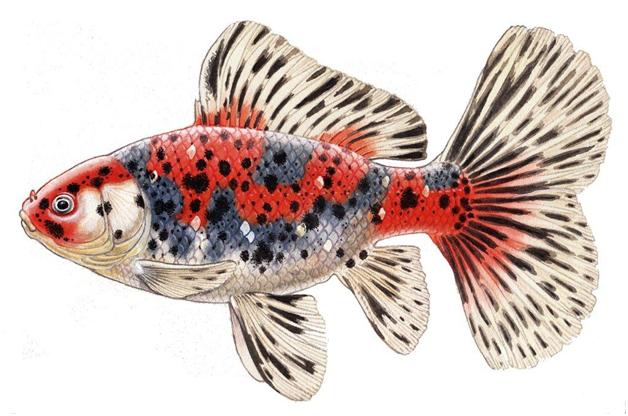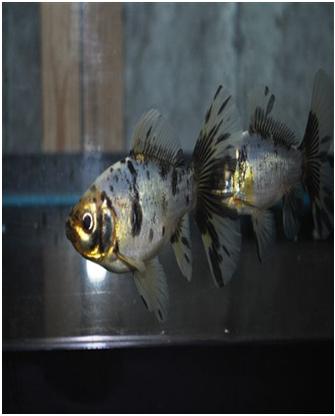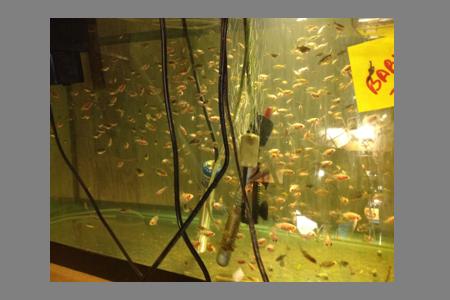Goldfish Selecting and Rearing - Bristol Shubunkin By Gary Hater
Bristol Shubunkins an English variety were created by amateur hobbyist in the time period between WWI and WWII. The classic English literature has them described in the early 1930ís.It was created by crossing a Japanese Shubunkins to a Demekin ( Black More Telescope).The fish is a four colored fish; black, red, blue and white. The classic variety is mostly blue with black speckles and a red stamp. It was preferred that the red be on the head. Over the years several breeding group and fry were imported. In the US, these are the premier single tailed fish, that still only available from hobbyist. It stands out from the other single tailed fish by having a heart shaped tail. The classic Bristol fish has tail fin rays that leave the peduncle at a 50o angle. Very recently there has been an effort in England to change this tail pitch to be more like 80 to 90 degree angle, Figure 1.

Figure 1: Modern Bristol (illustration by Merlin Cunliffe)
Breeding these fish is somewhat of a challenge, as with most hobby breed goldfish the Bristol lends itself to inbreeding very quickly in a small set up. This results in three types of Bristolís, males, female and undecided. The undecided often lack the interest in breeding and many a hobbyist end up with a grouping of fish that seldom spawn. There are four basic types of spawns generally used and they have varying types of offspring, Table 1.
Table 1: Typical Bristol crosses and there fry ratio predictions.
1.Metallic X Calico or nacreous. ( 50% Calico and 50% Metallic)
2.Calico X Calico ( 25% Matt, 50% Calico and 25% Metallic)
3.Calico X Mock metallic (50% Calico and 50% Metallic)
4.Matt X Metallic ( 100% Calico)


Figure 2: Modern day Bristolís from the my #2 breeding group.
The Mock Metallic X Calico cross is used infrequently to maintain the pastel colors in the skin and to keep the scales transparent. In order to prevent inbreeding we either import new fish (nearly impossible) or swap fish with other hobbyist. As pictured in Figure 2, the second photo, most people conduct mop spawning as hand spawning is possible but difficult with these slim bodied fish.
Culling
Eggs hatch in 4 Ė 5 days at 68F to 72F. The fry are generally vigorous and eat live brine shrimp once they are free swimming, day 2 or 3 after hatching. Note, with fish spawns from parents that are less than one year (this is common) APR (artificial plankton rotifer is often used as a first meal). In my hobby the fish are grown for about two weeks before any culling is performed. The exception is poor swimmers and bottom huggers, with are siphoned off. At two weeks the spawn should be spread over several tanks. Once the metallic are obvious the majority are culled in order to make room.
At four weeks the fish have tails that are visible and fish with pointed ends can be removed ( if you eyesight is good). Also red, black and yellow start to show up, these are keepers. If you have empty space these can be pulled out and raised separately. At this point and for the next 4 weeks you have mostly pink fish, Figure 3.

Figure 3: Eight week old fry in a 75 gallon tank.
Now, selection for the best colored fish begins in earnest. Many people cull the wrong fish at this stage as they are not patient enough. Black tails also begin to develop at this time. The blueness starts as micro- spots on the pink skin. Also note that because of the mock metallic genes in these fish, the calicoes often have black eyes. Another issue is that some of the matt fish do color. There are several additional faults that develop, Table 2.
Table 2: Other culling faults to look for and remove.
1.Peduncle is too long
2.Tail is too short or too tall.
3.Sucker mouth and twisted mouth.
4.Telescope eyes
5.Twin tails.
When you breed a distant related fish to another breeding group the telescopes and twin tails tend to show up. When you get sucker mouths or twisted mouths it is generally and indication that it is time for an outcross. While Figure 4 is a pretty poor picture, but it gives you a great idea as to the classic coloration desired.

Figure 4: Classic Bristol coloration.
Now at ten weeks you have two options, cull the remainder of uncolored fish or put the rest outside in a pond or tub where the intense sun light will bring out the blue fish.






